Pistachio Mafroukeh (Truffles)
A traditional Middle Eastern delicacy with a new twist! A semolina-based pistachio concoction, with an ashta cream surprise center, is turned into bite-sized truffles for the ultimate party treat! A simpler, traditional method also included. Plus…recipe VIDEO at the end of the post!

If you thought Middle Eastern cuisine has had its fill of pistachios, think again.
Pistachios are part and parcel of the region’s food, and we can’t help but sit back and enjoy its excessive use.
A light splash of ground pistachios here, a sprinkle of sliced pistachios there, is second nature to Middle Eastern cooks and we’re not complaining one bit.
This Mafroukeh on the other hand, will make other pistachio-kissed desserts, literally green with envy.
It is the mother of all pistachio sweets and a true depiction of the nut’s beauty.
It takes pistachios from a pretty and tasty addition in other sweets to center stage, where it becomes the star of the show.
It is the dominant flavor, shining color and pleasing texture.
So if you’re a fan of pistachios, you’re gonna fall in love with Mafroukeh.
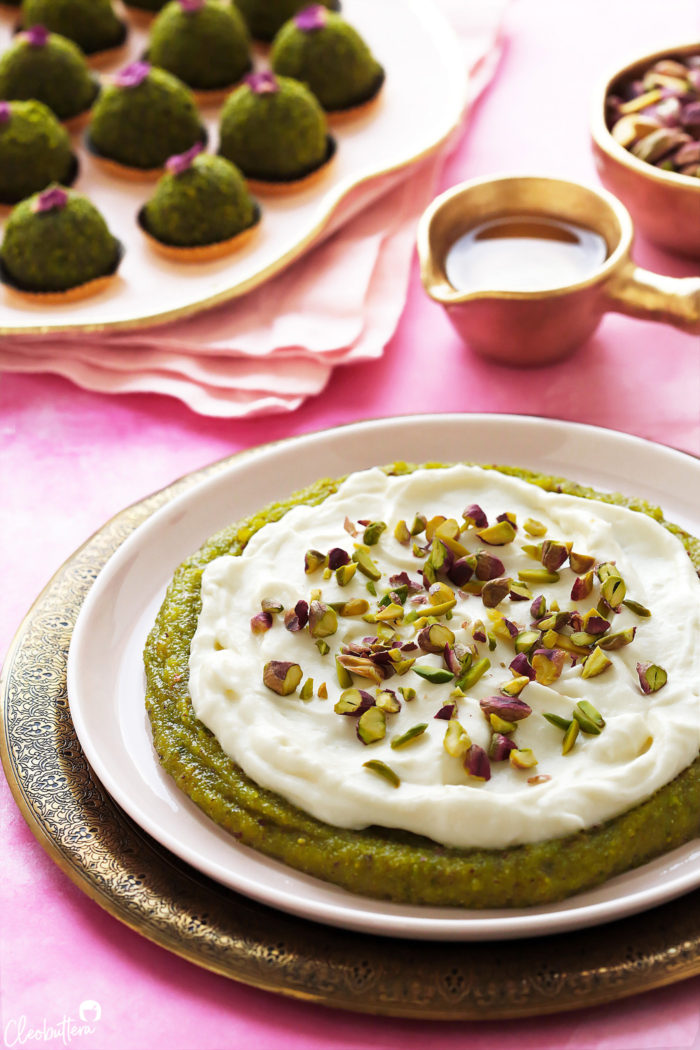
What is Pistachio Mafroukeh?
Also known as Fosdoe’ya (Arabic for Pistachio-y), this Lebanese delicacy is not well known in Egypt, where I’m from, but is really popular and much loved in the Levant region of the Arab world.
My sister-in-law, Rana, introduced it to us a few years ago and has since became the specialty we all beg her to make. I have tried making so many recipes before this one, and can vouch that hers is the absolute best…it’s just perfection. She was kind enough to let go of her eyeballing cooking style for me, and meticulously weigh out everything to allow me to share it with you. So we all owe it to Rana ?
Mafroukeh is basically a semolina-based pistachio concoction, with a paste-like texture, that is both creamy and crunchy, with floral notes from orange blossom and rose water. Topping (or stuffing) it with a dreamy, creamy layer of ashta cream, and an optional drizzle of sugar syrup, takes it from delicious to divine.
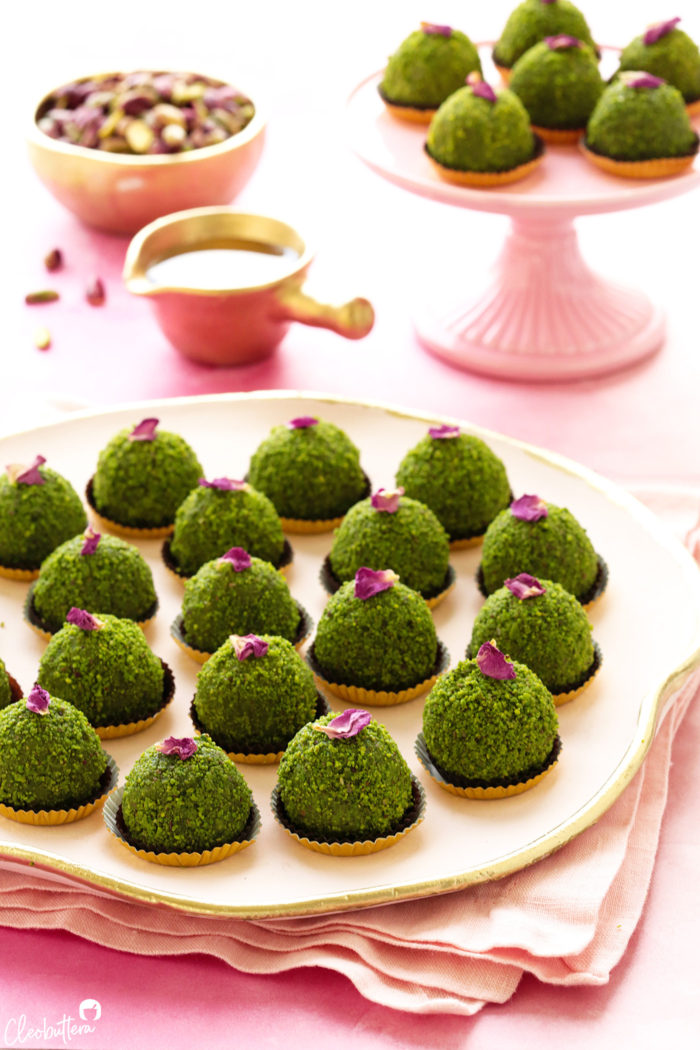
There’s no one way of presenting it. Its pliable consistency lends it to take on many shapes and sizes and can be molded in whatever form you like. From simply spreading it into a humble layer over a flat dish, to molding it into elegant fluted brioche forms or as a crescent for Ramadan (check my instagram highlights for that)...this dessert has no shape limits.
Which is why I’m showing you two variations today!
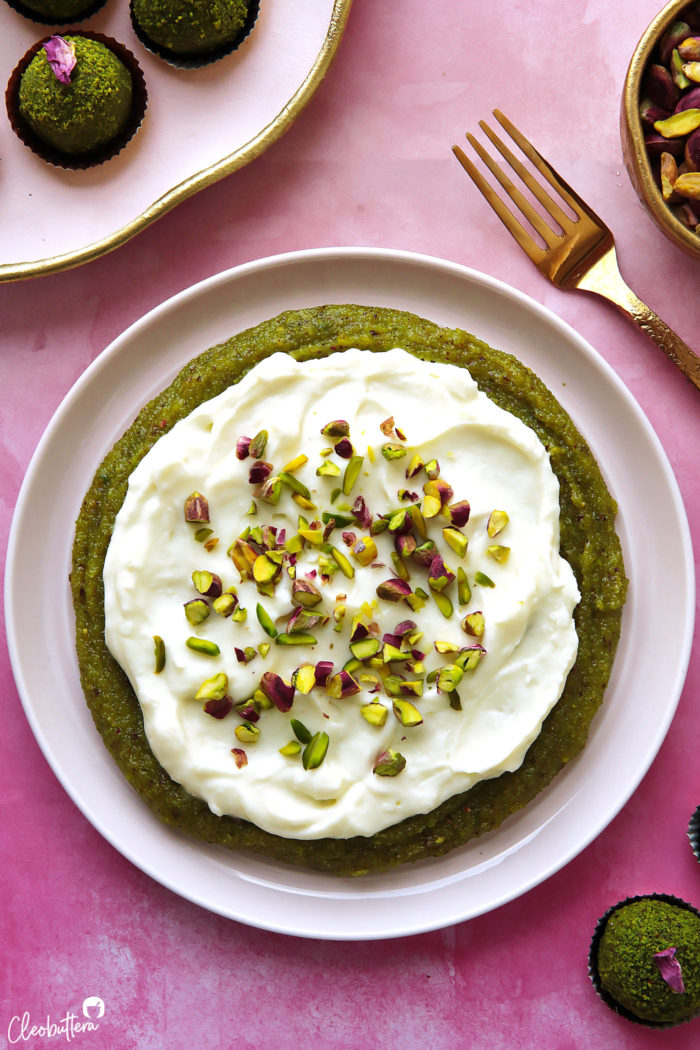
I couldn’t make up my mind on how to present it for the blog; so many beautiful styles to pick from. I was going back and forth between quick and simple, or over-the-top and elaborate.
Until I stumbled over these beauties from Sweet and Savory Food, and I just couldn’t resist the cuteness overload! It was my first time seeing mafroukeh as truffles and absolutely fell in love with its charming, finger-food appeal. And I also have a sweet spot for anything mini.
But I knew, that its multi-step nature of stuffing and rolling the truffles might deter many of you from trying the recipe all together, so I made sure to include and dump-and-serve style variation for the couch potato in you (myself included for the most part).
As for those who don’t mind a little extra work, in return for a stunner with a creamy surprise center…I present you with Mafroukeh Truffles.

All the deliciousness of the pistachio-y treat in a bite-sized bonbon from heaven.
Filled with an easy, homemade ashta cream, these tiny truffles prove that great things come in small packages.
The mafroukeh is perfectly sweet on its own, and I personally don’t feel the need for the traditional side of sugar syrup, but I have a thing for drizzles in photos. So there goes the syrup!
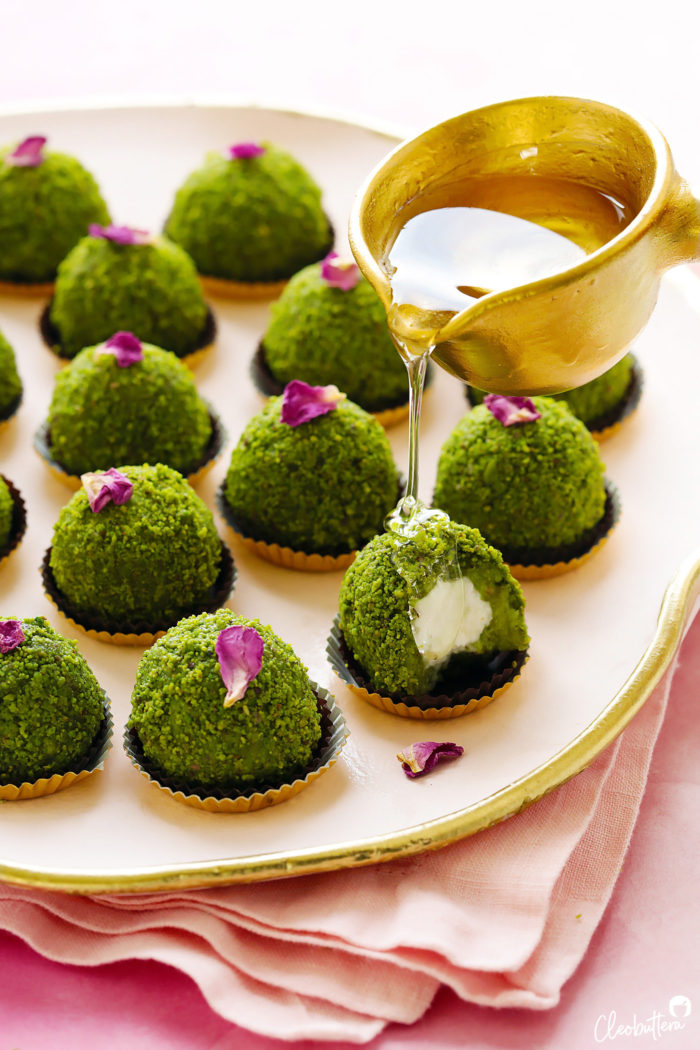
How to make Pistachio Mafroukeh (Truffles)?
It’s actually really easy to make, unless you’re going for the truffle option, which is still easy, but just more involved. The dough comes together in a matter of minutes over the stovetop and doesn’t require any baking!
This particular recipe has just the right balance of everything and comes out perfect every time. The perfect amount of pistachios, complimented with just enough flavoring and the sweetness is on point. I love my homemade recipe of ashta cream here; it’s just the right contrast to the nuttiness of the mafroukeh.
I have experimented with so many mafroukeh dough recipes, including ones that are made with ground kunafa dough instead of semolina, but this one is by far the most successful and practically flop-proof. I have even accidentally doubled the amount of butter that my sister-in-law uses and decreased the sugar, but decided to keep it that way, because my “mistakes” made it even more amazing.
So Let’s make it!
First begin by making this homemade ashta cream as per its recipe instructions. You can absolutely go for a shortcut and use store-bought ashta if you like.
I use my favorite method for stuffing cookies here, which is to freeze the filling to make for an easy and mess-free filling process.
Pipe 1 teaspoon-sized dollops of ashta all over a baking sheet. Then press on the peaks with a damp finger to flatten so that they’re more round. Then pop in the freezer until solid.
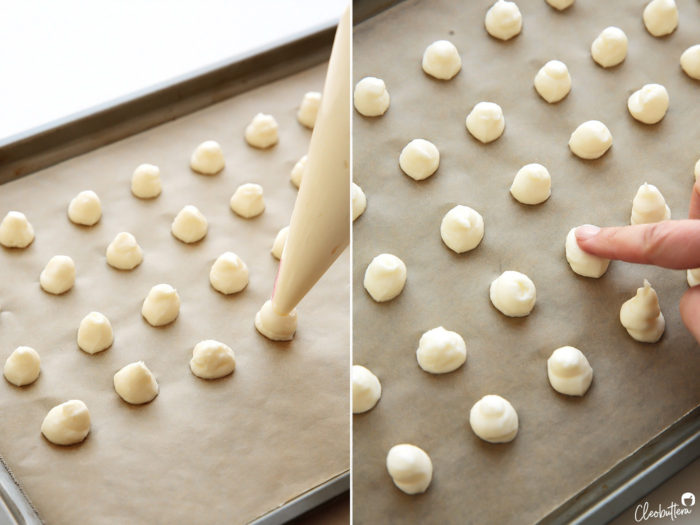
Then to make the mafroukeh dough, pulse together the pistachios with 2 tablespoons (25g) of the sugar called for in the recipe….
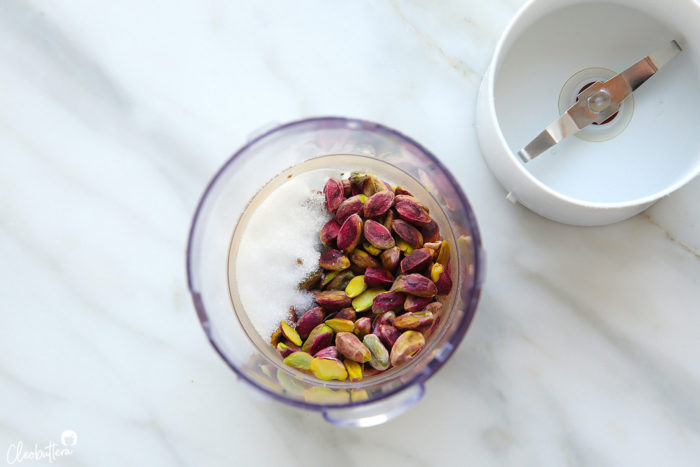
Until very finely ground. Be careful not to over-process the mixture, to avoid turning the pistachios into pistachio butter. Set that aside.
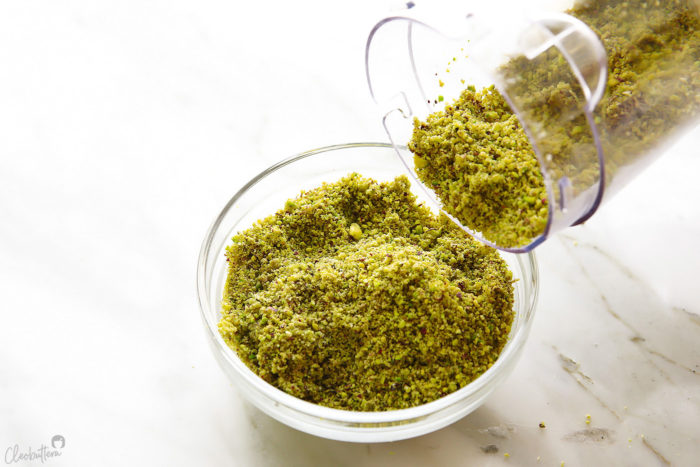
Then cook semolina in butter until barely starting to smell fragrant; about 2 minutes.
Although some people like to toast the semolina until it takes on some color, I personally prefer not to, as the toastiness distracts from the pistachio flavor.
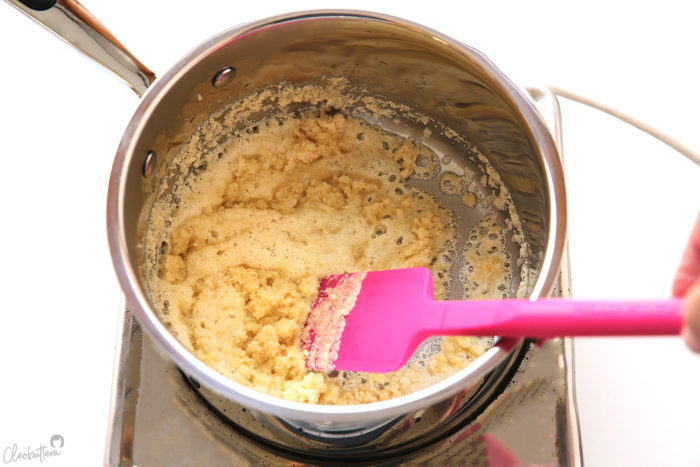
Then pour in the water…
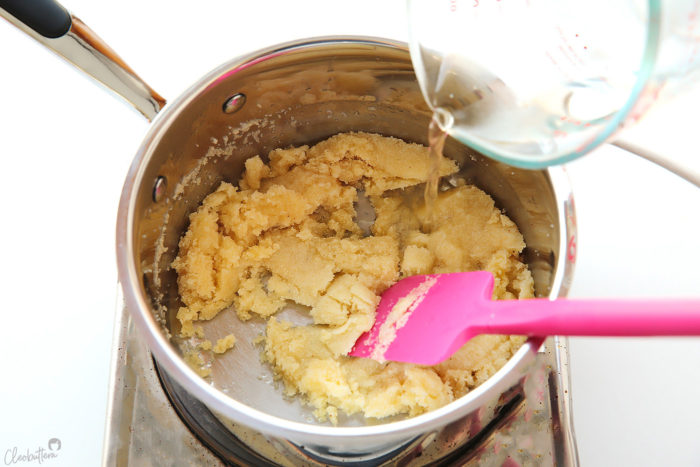
Followed by the sugar, and stir.

The mixture will start out looking very loose and soupy. So continue cooking, until the semolina has absorbed all the moisture, comes together in one mass and pulls cleanly from the sides of the pan, about 3 minutes. Mixture should resemble mashed potatoes in consistency.

Then add in the ground pistachios, along with the rose and orange blossom water.
Those 2 flavorings are usually optional, but I urge you not to omit them this time. They really bring out an amazing dimension to the pistachios that would otherwise taste flat. Use one or the other, reduce the amount if you have to, but don’t omit them all together.

Stir until well combined and a dough forms…
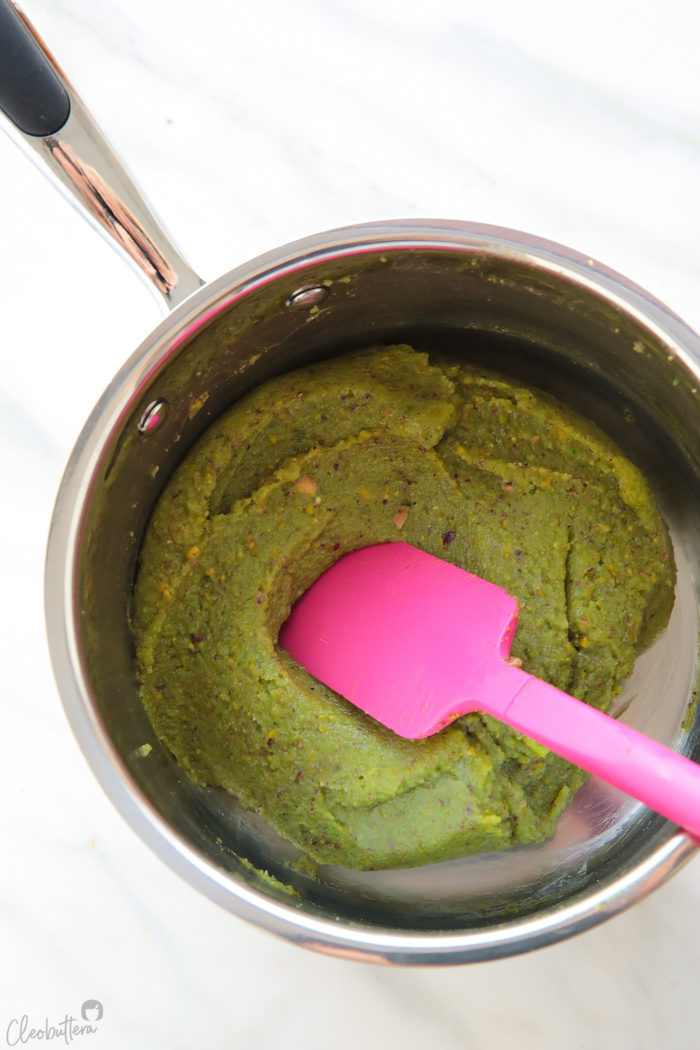
Now if you’ll go for the dump and serve option, just plop it on a plate while still warm, smooth it out, then when it’s cooled, spread on the ashta cream, sprinkle with pistachio and you’re all good to go!
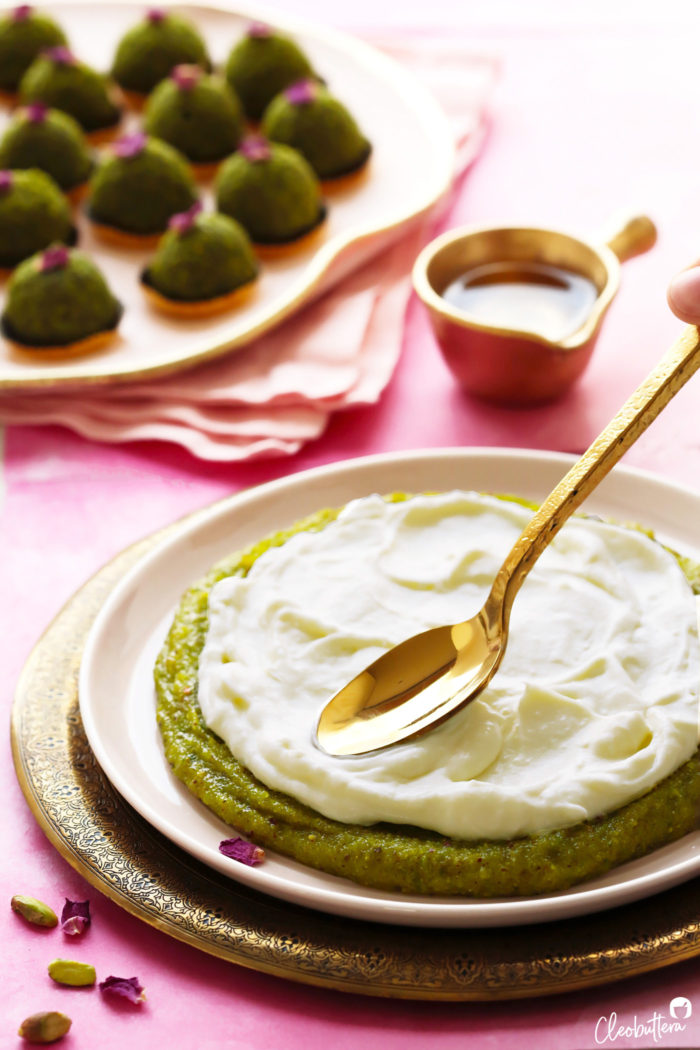
But if you’re feeling extra and all about the glam…
Scoop out the dough after it has cooled, then make indentations with your finger for the ashta to sit in.
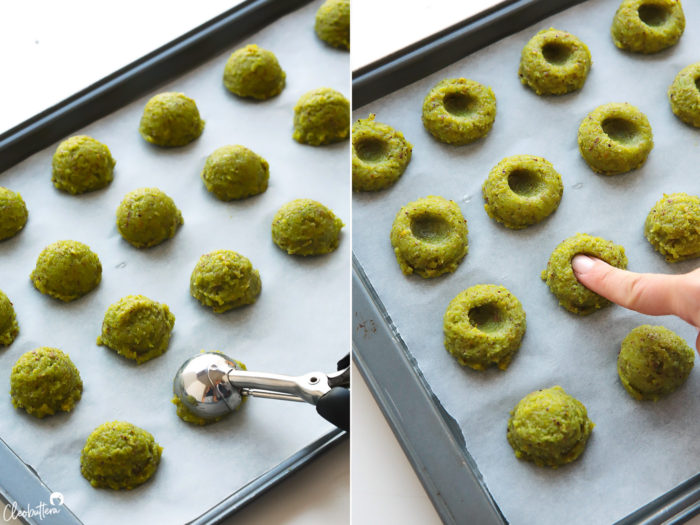
Working quickly, place the frozen ashta inside each indentation, gather the dough around it, roll into a nice and smooth ball, then coat with even more ground pistachios!
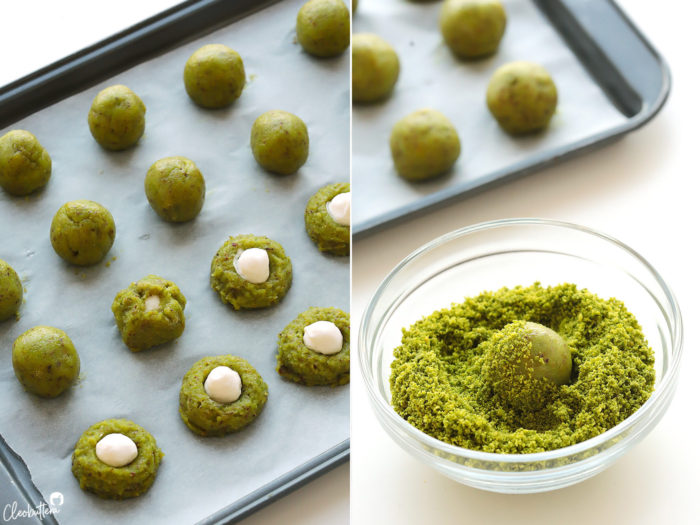
A little dried rose petal for color (that is if you can find it of course)

And there you have it…Mafroukah (2 ways) to satisfy the pistachio lover in you.
Check out this video for the Truffle variation! And don’t miss out on the crescent-shaped one on my Instagram highlights labeled ‘Mafroukeh.’
Pistachio Mafroukeh (Truffles)

A traditional Middle Eastern delicacy with a new twist! A semolina-based pistachio concoction, with an ashta cream surprise center, is turned into bite-sized truffles for the ultimate party treat! A simpler, traditional method also included. Plus...recipe VIDEO at the end of the post!
Ingredients
For the Ashta Filling:
For the Mafroukeh dough:
- 1 cup (114g) unsalted pistachios, shelled, lightly toasted & cooled*
- 3/4 cup (150g) granulated sugar, divided
- 1/4 cup (57g) unsalted butter
- 1/2 cup (80g) semolina, medium grind*
- 1 cup water
- 1 tablespoon orange blossom water
- 1 teaspoon rose water
For garnishing:
- Chopped pistachios, for the "cake" variation
- Ground pistachios, for the truffle variation
- Edible dried rose petals*
To serve: (optional)
Instructions
To prepare the Ashta filling:
- Prepare the ashta cream as per the recipe instructions and cool it completely. Once cool, transfer it to a piping bag with the end snipped off to expose a 1cm opening.
- Line a baking sheet with parchment paper or a silicone mat. Pipe 1 teaspoon sized dollops of ashta all over the sheet. Lightly wet the tip of your finger with water, then press on the peaks to flatten so that they're more round.
- Cover lightly with plastic wrap and transfer to the freezer until fully frozen and solid; about 1 hour, no longer than 2 hours. Meanwhile, prepare the mafroukeh dough.
To make the Mafroukeh Dough:
- In a food processor, pulse together the pistachios and 2 tablespoons (25g) of the sugar until very finely ground. Be careful not to over-process the mixture, to avoid turning the pistachios into pistachio butter.
- In a medium saucepan, heat the butter over medium-high heat until melted. Add in the semolina and stir until all the grains are well coated with the butter. Continue sautéing until just begins to smell fragrant; about 2 more minutes. It should barely change color.
- Add in the water and the remaining 1/2 cup plus 2 tablespoons (125g) sugar and stir to combine; mixture will be very loose. Continue cooking the mixture, stirring continuously, until the semolina has absorbed all the moisture, is no longer loose, comes together in one mass and pulls cleanly from the sides of the pan, about 3 minutes. Mixture should resemble mashed potatoes in consistency.
- Add in the ground pistachio mixture, both the orange blossom and rose waters, and stir until well combined and homogeneous.
For the single layer variation:
- Transfer to a serving platter and spread into a 2-cm thick, about 9-inches circle (or any shape you prefer), and let cool completely (at room temp or in the fridge) before topping with the ashta.
- Once cool, spread the ashta all over the top. Use as much or as little ashta as you like; I use all of it. Then garnish with chopped pistachios. Keep refrigerated until serving time. Serve cold or at cool room temperature.
For the truffle variation:
- Transfer to a bowl, and refrigerate until cooled to room temperature or colder; about 30 minutes. Once cool, be sure not to stir it again, as this soften the dough and makes too sticky.
- Line another baking sheet with parchment paper or a silicone mat. Once cool, use a tablespoon-size ice cream scoop (or a measuring tablespoon), to scoop dough balls onto the baking sheet.
- Using your thumb or finger, make a deep indentation into each dough ball.
- Take the ashta balls out of the freezer and working quickly, peel the frozen ashta from the baking sheet and place one inside each indentation of every dough ball. If you're working in a warm kitchen, you might want to keep the frosting scoops in the freezer, taking only one by one as you work, to prevent them from softening.
- Gather the dough over the ashta balls to completely cover them. Roll the dough into smooth balls, making sure the ashta is completely wrapped inside and nothing is peaking out.
- Roll the mafroukeh truffles in ground pistachios to coat. Top with dried rose petal, if available. Place in mini cupcake liners if desired and arrange on serving platter. Keep refrigerated until serving time. Serve cold or at cool room temperature.
- Both mafroukeh variations will keep well in the fridge, well covered, for 2 days. For the truffles, it is best to coat them with the outer layer of pistachios, on the same day they're served.
Recipe Notes
- Feel free to substitute the Homemade Ashta Cream filing with about 200g of store-bought fresh ashta, not canned. Mascarpone cheese may be used to.
- I have tried this recipe with blanched and skinned pistachios, and didn't love the taste as much as I like the one made with the pistachios skins. So although the skin adds specks of brown color into the dough, it does add a much nicer and deeper flavor. As for the smoothness, the difference is unnoticeable. So don't bother with skinning the pistachios and use them as is.
- I like to very lightly toast the pistachios here, to bring out their flavor; its optional though. To toast them, place the pistachios in a 180C oven for 5 minutes or less...juuuuust until it starts smelling fragrant. Make sure they have fully cooled before grinding them.
- Semolina is known in Arabic as ‘semeed.' The one used here is white and medium grind, also referred to #2 semolina in some countries. I've use both Sonbolat Al Forat and 5 stars, Egyptian brands, with great results.
- Although usually optional, I urge you not to leave out the orange blossom and rose water here. They really bring out an amazing dimension to the pistachios that would otherwise taste flat. Use one or the other, reduce the amount if you to have to, but don’t omit them all together.
- The edible dried rose petals might be hard to find in some countries, including where I live, Egypt. I got these from a recent trip to Saudia Arabia, and I'm pretty sure they're available in Lebanon.
- Since sugar syrup is traditional accompaniment with mafroukeh, I added it to the ingredient list, although I don't feel it's necessary here. The dough has just the right amount of sweetness just the way it is. Feel free to add it in if you like the extra sweetness. If you'd like a smaller amount of syrup...use this recipe instead.
Recipe gifted to me by my dear sister-in-law, Rana. Her recipe is the best version of pistachio mafroukeh I've ever made.
Truffle look inspired by Sweet and Savory Food.
Measurements Note: All recipes of this site have been developed using weight measurements. Although US volume measurements have been included for your convenience, it is highly encouraged that you weigh your ingredients using a kitchen scale to get the best possible results. Due to the sensitive nature of baking, kitchen scales are proven to yield more accurate and consistent results than measuring cups. Enjoy!
This post may contain affiliate links.
All images and content are owned by Cleobuttera® and are copyright protected. Please do not use my images without prior permission. If you would like to republish a recipe, please rewrite it in your own words and link back to the recipe page on my site. Original recipes and creations of this site are intended for personal and home use. Commercial replication or media consumption are only allowed with a written consent and agreement with Cleobuttera owners. Otherwise it is considered a violation of intellectual property. Thank you for respecting and appreciating the amount of time and effort that goes into creating free, unique recipes that make people happy.